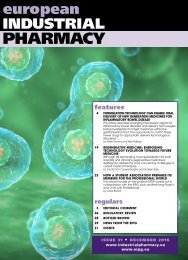PHARMACY
eip26-sep15
eip26-sep15
- No tags were found...
You also want an ePaper? Increase the reach of your titles
YUMPU automatically turns print PDFs into web optimized ePapers that Google loves.
FIRST-IN-CLASS INNOVATION<br />
IN THE PIPELINE FOR<br />
TREATMENT OF MUSCULAR<br />
DYSTROPHY<br />
by Angel Wong<br />
Duchenne research has gained momentum recently<br />
with the first innovative therapy to treat the<br />
underlying cause of a nonsense mutation in the DMD<br />
gene. The exceptionally high level of innovation and<br />
diversity in the pipeline will open up numerous<br />
opportunities for more novel products to thrive, creating<br />
an encouraging outlook for the vast majority of muscular<br />
dystrophy patients, as well as companies and investors<br />
in the market.<br />
Angel Wong is a Senior Analyst for business intelligence provider GBI Research. She has a<br />
particular interest in molecular cell biology and immunology. Angel holds a BSc in<br />
Biochemistry from the University of Nottingham and an MSc in Management from<br />
Loughborough University.<br />
Muscular dystrophy is a group of<br />
heritable, genetic neuromuscular<br />
disorders characterised by<br />
progressive muscle weakness and<br />
degeneration. The most common<br />
types of muscular dystrophy are<br />
Duchenne muscular dystrophy<br />
(DMD) followed by its milder form,<br />
Becker muscular dystrophy (BMD).<br />
Both diseases are caused by<br />
mutations in the single DMD gene<br />
on the X chromosome, and as a<br />
recessive disease, this means it is<br />
exclusive to males.<br />
Dystrophin, which is the protein<br />
product of DMD, is a rod-shaped<br />
cytoplasmic protein expressed<br />
primarily in skeletal muscles and<br />
cardiac muscles. It associates with<br />
various proteins, including<br />
α-dystrobrevin and β-dystroglycan,<br />
to form the dystrophin-associated<br />
protein complex (DAPC) at the<br />
sarcolemma (cell membrane of a<br />
muscle fibre cell). The DAPC<br />
functions as the structural link<br />
between the actin cytoskeleton and<br />
extracellular matrix, which is crucial<br />
for normal muscle function during<br />
muscle contraction and relaxation.<br />
Destabilisation of the sarcolemmal<br />
a DAPC, which can arise from<br />
mutations in DMD, leads to<br />
increased susceptibility to muscle<br />
fibre damage and necrosis. Most<br />
DMD-causing mutations shift the<br />
reading frame by one or two base<br />
pairs, resulting in the addition of<br />
incorrect amino acids to the<br />
polypeptide. A nonsense mutation,<br />
for instance, leads to a premature<br />
stop codon, causing early<br />
termination of translation and the<br />
production of truncated, nonfunctional<br />
dystrophin.<br />
Symptoms such as delay in age of<br />
walking generally arise in boys after<br />
the age of five. By late childhood,<br />
they typically lose the ability to<br />
walk, and may develop life<br />
threatening cardiac and respiratory<br />
complications during their late<br />
teens as heart and lung muscles<br />
weaken. Despite similar symptoms,<br />
the disease progression in BMD is<br />
slower, as it is caused by nonframeshifting<br />
mutations which retain<br />
partial protein function of<br />
dystrophin.<br />
It has become increasingly<br />
apparent that dystrophin deficiency<br />
is not the only factor driving disease<br />
progression, particularly when<br />
muscle fibre degeneration has been<br />
long regarded as a multifaceted<br />
process. Following sarcolemmal<br />
defects, secondary pathological<br />
processes that may contribute to<br />
the hallmarks of DMD/BMD include<br />
mechanical stress, deregulated<br />
calcium homeostasis, impaired<br />
vascular adaptation and<br />
inflammation. Ultimately, increased<br />
muscle necrosis, coupled with the<br />
failure to repair damaged muscles,<br />
leads to replacement of muscle<br />
fibres by adipose and connective<br />
tissues, namely fibrosis.<br />
Current treatment<br />
Over the past few decades, generic<br />
glucocorticoid treatment,<br />
specifically prednisone and<br />
deflazacort, remains the mainstay of<br />
pharmacological treatment of DMD<br />
and BMD. They are glucocorticoid<br />
receptor agonists which act by<br />
suppressing transcription of<br />
inflammatory genes via activation of<br />
NF-KB. In clinical studies,<br />
prednisone and deflazacort were<br />
shown to offer similar symptomatic<br />
benefits in improving muscle<br />
strength, delaying the loss of ability<br />
to walk and stabilising pulmonary<br />
function in DMD patients 1,2 .<br />
Although the exact mechanism that<br />
gives rise to the clinical benefit<br />
remains unclear, they are thought to<br />
upregulate expression of musclespecific<br />
target genes via the<br />
calcineurin/nuclear factor of the<br />
activated T-cells pathway, such as<br />
utrophin (an autosomal homologue<br />
of dystrophin), which has a<br />
structural role similar to dystrophin 3 .<br />
Like other glucocorticoids,<br />
prednisone and deflazacort are<br />
associated with significant adverse<br />
events, including weight gain and<br />
increased risk of vertebral fractures.<br />
Studies showed that deflazacort is<br />
associated with less weight gain<br />
and more preservation of bone<br />
mass, making it the preferable<br />
treatment over prednisone in<br />
patients with pre-existing weight<br />
issues 4 .<br />
Apart from muscle weakness,<br />
secondary complications<br />
comprising respiratory,<br />
cardiovascular and orthopaedic<br />
issues are managed with<br />
4<br />
european INDUSTRIAL <strong>PHARMACY</strong> September 2015 • Issue 26





